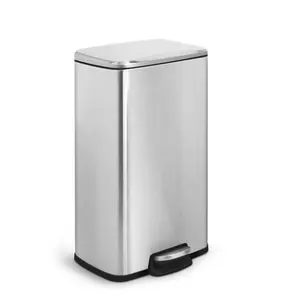
Commercial Trash Can DA-78D Outdoor Steel And Wood Garbage Can Trash Bin Commercial Garbage Bin Outdoor Trash Receptacle


















A foot pedal garbage can is a waste bin activated by a foot lever, enabling users to discard rubbish without making hand contact with the lid. This feature is particularly advantageous for preserving cleanliness and curbing the proliferation of microbes. The foot pedal garbage can is crafted to facilitate efficient and convenient refuse disposal across a range of environments, from residential to commercial spaces.
There exists a vast array of foot pedal garbage cans on the market, each tailored to suit distinct requirements and tastes. The 13 gallon step on trash can is a prevalent selection for households, adept at accommodating everyday waste without occupying excessive space. Larger venues such as eateries or medical facilities may opt for bins with capacities of 50L, 120L, or even 240L, often mounted on wheels for effortless transport. Dual-compartment step garbage bins are gaining favor for their capacity to segregate recyclables from non-recyclables, thus fostering eco-friendly practices. Additionally, specialty receptacles with features for odor control and stylish designs are available, appealing to niche segments that value both utility and style.
The step garbage bin is deftly engineered to marry ergonomic design with practicality. The foot pedal at the base, when depressed, triggers a linkage system that elevates the lid. This mechanism is typically constructed from robust metal to endure frequent usage. The lid may incorporate a soft-close feature to diminish noise and extend its lifespan. Certain models include a secondary pedal to secure the lid, adding an extra measure of scent containment and safety. Internally, the bin might have a detachable liner or bucket, streamlining the process of changing bags and maintaining hygiene.
When crafting step can trash cans, manufacturers prioritize materials based on their longevity, visual appeal, and environmental impact. Stainless steel is preferred for its modern appearance and resistance to smears and fingerprints. Plastics such as HDPE are chosen for their lightweight and ease of sanitation, and are commonly used in outdoor models due to their durability against the elements. Galvanized steel is selected for industrial or outdoor bins for its sturdiness and rust resistance. The material selection not only influences the bin's durability and functionality but also its potential for recycling and ecological footprint.
Step on trash cans play a pivotal role in waste management strategies across diverse commercial sectors. In the culinary industry, they uphold hygienic standards by enabling kitchen staff to dispose of refuse without risking contamination. Healthcare institutions rely on them to inhibit pathogen transmission. In office environments, their sleek designs integrate seamlessly while offering practicality. The hospitality sector prizes them for their harmonious blend of design and sanitation, ensuring that guest areas and communal spaces remain immaculate. The design and functionality of these bins are instrumental in upholding health standards and augmenting customer satisfaction.
The trash can with foot pedal is conceived with particular functions in mind. Its pedal mechanism affords a sanitary method for waste disposal, essential in places where cleanliness is of utmost importance. Some bins come with a dual-function pedal system, where one pedal opens the lid and another may engage a locking feature or activate a separate compartment. Such multifunctionality is vital for environments demanding rigorous waste management protocols, like medical or food preparation areas.
Contemporary step can garbage bins are distinguished by a suite of features that set them apart from conventional waste containers. Innovations such as anti-fingerprint coatings, silent-close lids, and integrated wheels for larger models refine the user experience. Certain garbage bins with foot pedal also boast UV coatings to inhibit bacterial and mold growth, a significant aspect for healthcare settings. The adoption of smart technology in some variants enables monitoring of waste levels and automated scheduling for trash collection, optimizing business operations.
Employing a foot pedal trash bin yields multiple advantages. It fosters a germ-free environment by minimizing the need to touch the bin's surfaces, thereby reducing the risk of transmitting germs. For businesses, this translates to compliance with health regulations and a safer setting for both staff and patrons. The hands-free operation further enhances efficiency in waste disposal, contributing to a more streamlined workflow. Moreover, the diverse designs of these bins can improve the ambiance of their surroundings, creating a more agreeable atmosphere.
A foot pedal garbage can bolsters cleanliness by reducing the necessity of physical contact with the bin. This hands-free functionality is vital for averting cross-contamination and the dissemination of bacteria, particularly in settings where hygiene is a primary concern, such as kitchens and healthcare establishments.
In the process of selecting a foot pedal trash bin, it is important to contemplate the size and capacity—13 gallon models are esteemed for striking a balance between spatial efficiency and utility. Material choice is another factor; stainless steel ensures resilience and ease of maintenance, whereas plastic options may be lighter and more economical. Additionally, the design should be appropriate for the intended environment and user needs.
To preserve a garbage bin with foot pedal, regular cleansing is imperative to avert odors and microbial accumulation. It should be emptied often, and both the interior and exterior should be sanitized with a disinfectant. For metallic bins, eschew abrasive cleaners to avoid scratches, and for plastic variants, a gentle soap solution typically suffices.